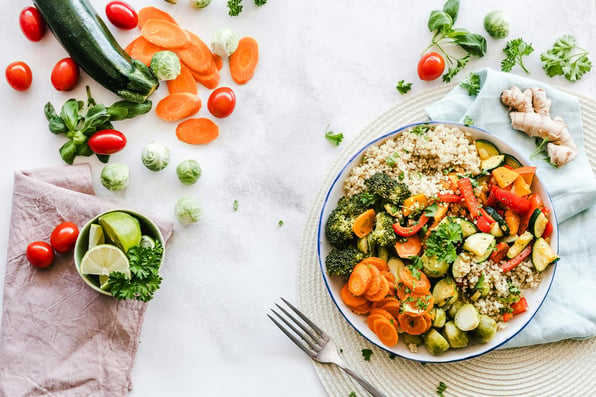Having a healthy, delicious, and quick to prepare lunch at work might seem hard. If your employee wellness strategy misses out on the discussion of nutrition, this piece about healthy cold lunch ideas for work would be a great place to start.
A healthy meal: The rule of 3
The rule of three is a rule that helps you decide what to include in a meal in terms of foods. Following this rule helps you meet your nutrient needs and have a balanced meal intake to help with hunger–satiety regulation!
So, the rule of three for a healthy meal is to:
- Always include vegetables
- Have some protein (e.g., cheese, yogurt, egg, meat, fish)
- Have some starchy carbohydrates (e.g., potatoes, spaghetti, rice, bread, corn) and prefer unprocessed (e.g., whole grain products)
Healthy cold lunch options
Apart from generally speaking rules for eating healthy, we usually need to optimize our mental performance during work. Some foods seem to support that more than others, called brain foods. These are broccoli, onions, fish, eggs, whole grain products, dairy, and fruits such as berries, kiwis, grapes, and apples!
So, based on the above, here are some meals you can eat cold at work:
1. Lentils salad
You can find a lot of recipes here, and you can make your own, too, depending on your taste preferences. In general, you boil the lentils, add some vinegar, and then add shredded carrot, and depending on how intense you need this plate to be, you may also use avocado (not intense) or a cheese (might be intense in taste) in pieces. You mix them, and voila! Bon Appetit!
2. Lentils with rice
One of the usual meals cooked in Cyprus and one of the meals proposed to people following a vegan diet! This is an easy recipe and a nutritious and delicious meal!
But why is this recipe recommended for those following a vegan diet?
Amino acids (bricks building proteins) are important for the human body. The human body needs 20 of them, while many more are found in foods. Of those 20, some of them are called essential as the human body has not the ability to build them from their substances, and thus, it needs to take them from food.
These are mainly found in animal proteins, and so, to get them from vegan foods, you must make combinations that result in “animal-like proteins.” The proteins found in two foods that produce such a protein are called complementary. An example of “complementary foods” is grains and legumes.
3. Black-eyed peas with spinach
An easy recipe and a delicious and nutritious meal! Having boiled the black-eyed peas, you can use some of them to make the recipe with spinach and some to combine with boiled broccoli and cheese. Use lemon in both recipes!
4. Chickpeas or lima beans with vegetables and cheese
A cold green recipe to eat during summer! You boil the beans or chickpeas and combine them with vegetables such as fresh tomatoes, onions, cucumber, and cheese. You can add some olive oil and vinegar if you like! This meal is full of dietary fiber, protein, carbohydrates, calcium, and vitamin C! Enjoy!
5. Fish, meat, or poultry-based meals
You have plenty of options here! As you will be at work, the main thing is to use a fish fillet so you won’t have to bother yourself with the bones! So, you can use any of the fish fillets baked in the oven with potato and onion slices, or even red pepper slices, or you can have a boiled version with potatoes or rice and boiled vegetables such as broccoli, zucchinis, carrots, or cauliflower. The same applies to chicken and meat!
6. A fish, meat, or poultry-based wrap
If you had a meal with baked fish/ meat and you have some left, or if you baked some more to take it to work, you can use it in a wrap!
Be careful, though! As recommendations for healthy eating, advise to have half of your plate filled with vegetables, prepare a wrap with vegetables, preferably baked (fresh vegetables might not look good at the time of consumption at your work), and add dressing.
Vegetables that taste good here are peppers, zucchini, and carrots, and you may also have some potato slices. Try this chicken and roasted vegetables wrap recipe!
7. Pasta or cereal meal
Did you know that when our body sends us the sign of hunger, it asks mainly for carbohydrates? Well, foods made of cereals are a good source of carbohydrates, and if you prefer whole wheat of them, you give your body a nutritious and full of energy food!
So, when your batteries are low, prefer a meal with foods made from cereals. To have the ultimate result, follow the rule of 3! Use a food made from cereals (quinoa, pasta, etc.), vegetables, and protein food. This gives you a lot of choices!
You can use pasta, leftovers from meat or poultry sliced to pieces, vegetables - raw, cooked, or boiled, and a dressing with vinegar or yogurt! Another idea is to use pasta, a cheese you like to cut into pieces, and boiled, raw or baked vegetables!
You can find some cold pasta recipes here!
8. A vegetable-based meal
You have two options here! You can go with the plant-based meals (for recipes, click here) or with the mixed dishes! For the mixed dishes, you can use leftovers of almost everything (pasta, meat, fish, poultry, or boiled legumes) and add cheese, boiled egg, boiled corn, and a dressing. The vegetables can be raw (tomatoes, onions, or peppers) or boiled (cauliflower, broccoli, zucchini, carrots, beetroots). You can also use fresh beans or greens!
Be careful! If you use just vegetables, you might be hungry soon, so prefer to add some carbohydrates (potatoes, pasta, bread, rice) or legumes and some protein. You can use olive oil mixed with lemon or vinegar to make a dressing!
Don’t forget to add parsley and celery if you like, as these are believed to be brain foods!
Healthy eating recommendations
Healthy eating refers to consuming foods from specific food groups regularly and in particular portions. What are food groups? Each group contains foods that share similar nutrients. Some examples of food groups are Vegetables, Fruits, and Grains.
Each country has developed food-based guidelines to show precisely that: i.e., how many portions to consume of each food group and in what frequency. These national food-based dietary guidelines (FBDGs) provide specific advice and principles on healthy eating, which are evidence-based, and depict, among others, a country’s public health and nutrition priorities, food production and consumption patterns, sociocultural influences, and accessibility.
More than 100 countries have developed food pyramids and other schemes to depict these FBDGs, aiming to help the general public in applying them and thus, take all the required nutrients. Food and Agricultural Organization has gathered all these guidelines per country.
Check out yours by clicking on your country here, but be careful as these guidelines are for apparently healthy adults and aim to help you improve or maintain your health!
So, to practically implement the above guidelines, we use two “rules”:
- The rule of three and
- The weekly balance
Weekly balanced meals
Based on FBDGs, some foods are recommended to be eaten every week rather than daily. These usually are legumes, meat, poultry, fish, potatoes, eggs, and cooked cereal products (spaghetti, rice, etc.).
Even though each country has its recommendations, it is generally advised to have two meals/ week with fish, 1-3 meals/ week with meat or poultry, and at least 1-2 meals/ week with legumes or vegetable-based meals.
Cooked cereals and potatoes can accompany the above or be eaten alone as a meal combined with dairy or eggs. Also, eggs can accompany cooked-based vegetables if you use the rule of 3!
You can use this rule in two ways:
- You can make sure you have all the healthy foods (fish, legumes, vegetables-based dishes) at work, so you make sure you have eaten them during your working day or
- You may prefer to have some of them during your days off to prepare something more delicious or because you need more time for preparation.
Conclusion
Remember to avoid food waste! You can cook/ prepare precisely the portion that you will consume or use your leftovers to build a salad or a cold meal!
Preparation is the key to success:
- Think in advance of your weekly cold lunch menu!
- Buy the products you need to make your cold lunch meals!
- Find time to prepare your lunches!
Packing a healthy lunch for work doesn't have to be hard. These eight easy ideas will help you stay on track, without spending a lot of time in the kitchen. So get cooking and take your delicious and nutritious meal to go!
Originally published May 17, 2022 - 8:39 AM, updated September 3, 2024
SOURCE
WHO (2022). Healthy eating. Accessed at https://www.who.int/news-room/fact-sheets/detail/healthy-diet. Accessed on 19 April 2022.










